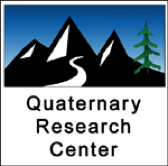Description
Since its inception, the QRC has been a hub of interdisciplinary research, drawing together UW faculty, students, associates, and visiting researchers in the study of everything from tectonics to climate, hydrosphere to ecosystems, and human evolution/adaptations to environmental impacts over the past 2.6 million years.
The “Quaternary” refers to the last 2.6 million years of Earth history, corresponding to the great ice ages and intervening interglacial periods. This interval embraces the history of humanity from the first stone tool users in Africa, human colonization of the habitable surfaces of the planet, agricultural innovations, and the economic diversification and intensifications that support a current population over 7 billion people. It encompasses major transformations of the Earth’s ecosystems through intervals of dramatic cooling and warming and anthropogenic habitat modification. Today, human “niche construction” has modified the majority of the earth’s surface, engendering significant impacts on the planet’s atmosphere, geosphere, hydrosphere, biosphere, and social systems.
Knowledge of environmental changes in the Quaternary facilitates an understanding of earth history in relation to the modern environment and future change. This link of the past, present, and future is fundamental to the interdisciplinary mission of the QRC. Processes set in motion through the Quaternary culminate today, in both intended and unintended anthropogenic impacts, at a global scale. Understanding this period thus requires science that considers the unique and interacting dynamics of atmospheric, aquatic, earth, biotic and social systems in interdisciplinary and comparative perspectives. Understanding the history, evolution, and variability of these linked systems forms the core mission of the QRC.
To that end, the QRC also embraces the study of a deeper time and even processes on other planets as they shed light on Earth’s Quaternary patterns and processes (e.g., processes and impacts of rapid warming in the Eocene or the geomorphological understanding of surface processes on Mars have implications for the future of a warming earth). This attention to comparative and time transgressive case studies at varying scales, centered on, but not limited to, the past 2.6 million years, makes the past relevant to the present and to our efforts to plan for a desirable future.
Members of the QRC are UW faculty, researchers, post-docs and students, as well as specially honored friends of the QRC from other institutions and even countries. If you are interested in becoming a member, please visit Becoming a Member for more information.
Partners
UW Bothell, College of Arts and Sciences, College of Built Environments, College of Engineering, School of Interdisciplinary Arts & Sciences (Bothell and Tacoma), Department of Earth and Space Sciences, Department of Anthropology, Department of Aquatic and Fishery Sciences, Atmospheric Sciences, Department of Biology, Burke Museum, Department of Civil and Environmental Engineering, Department of Environmental and Forest Sciences, Joint Institute for the Study of the Atmosphere and Ocean (JISAO), Marine and Environmental Affairs, Department of Oceanography, and Department of Urban Design and Planning;
Institute of Earth Environment, Chinese Academy of Sciences, US Geological Survey (USGS), University of British Columbia, Nuka Research and Planning, Simon Fraser University, University of Calgary, Seattle University, Edmonds Community College, Ground Truth Alaska, and Washington Sea Grant
